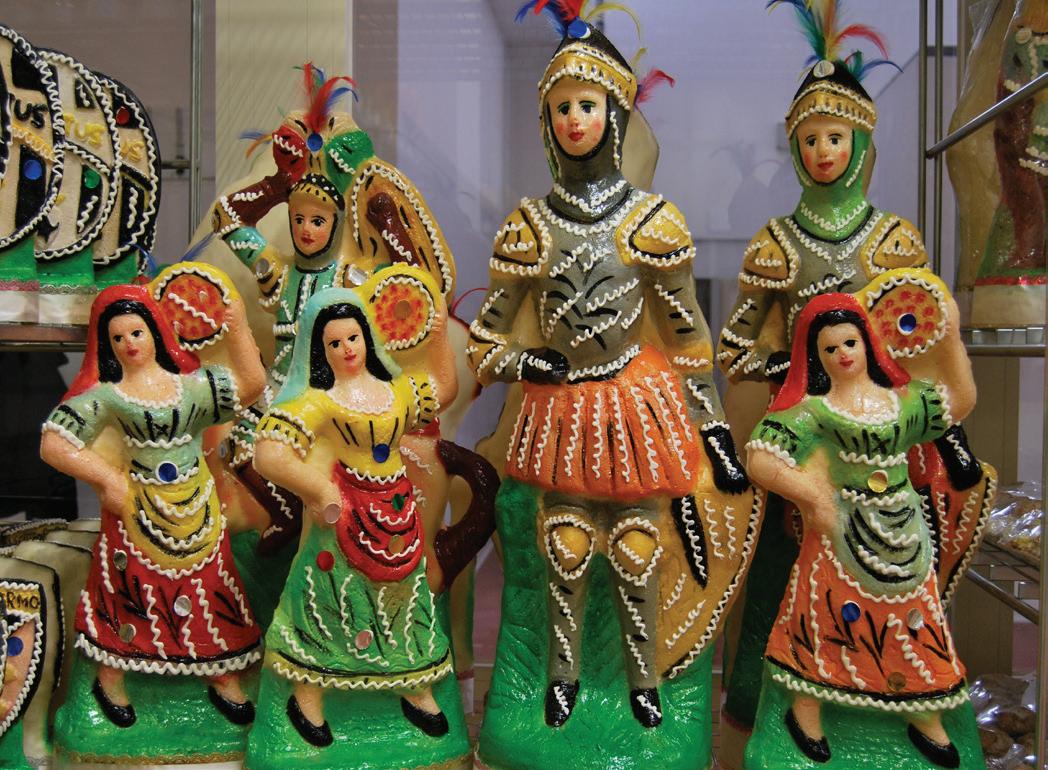
3 minute read
Day of the Dead Celebration Returns to Sicily
By Alberto Lunetta / NAS Sigonella Public Affairs

Be ready to tempt your taste buds with the traditional Pupi ri zuccaru or puppets of boiled sugar that are among the most popular “Day of the Dead” ancient religious holiday treats. They are baked into symbolic shapes. You will find them in all pasticcerie (pastry shops) and panifici (bakeries).
(Photo by https://italianocontesti.ru)
Advertisement
“Armi santi, armi santi, io sugnu unu e vuatri tanti. Mentri sugnu ‘ni stu munnu di guai, cosi ri morti mittiminni assai!” Translated as “Holy souls, holy souls, there are many of you and I’m one. Bring me a lot of presents while I’m in this world of troubles.” This old religious poem, which sounds like a letter to Santa Claus, is one of the traditional prayers that Sicilian children say before going to bed on the night of November 1, the day before the “Il Giorno dei Morti” (The Day of Dead), an ancient Catholic celebration honoring departed ancestors, loved ones and relatives. There is the excitement as they believe that, during the night, the spirits of the dead will visit their homes to bring them presents.
This heartfelt holiday is similar to the “El Dia de los Muertos,” a typical Spanish and Latin American celebration. Catholic families gather to make a pilgrimage to the cemeteries and spiritually reunite with their beloved ones.
According to tradition, the spirits of the dead are welcomed in a friendly way. Their annual “homecoming” is a time to be symbolically shared with their families and loved ones by eating, drinking, and reminiscing. It is a way to keep alive the connection between the living and the dead. According to some historians, this festive tradition, which blends paganism and the Holy Scriptures, dates back to early Christian’s times. St. Odilo, fifth Abbot of Cluny, first established it in 998 AD.
Sicilian anthropologist Giuseppe Pitrè says that in the past, Sicilian children would leave their shoes on windowsills in the hope that their dead relatives would place gifts for them. Traditions say dead relatives turn themselves into ants so they can easily enter into the homes to fill the baskets and the socks prepared by the kids with gifts. Since presents are only for good children, on the night of Nov. 1, kids who misbehaved promise to work on changing.
Over the past few years, the Il Giorno dei Morti tradition has been often opposed to Halloween, raising concern among Catholics who fear that the latter might overshadow this century-old religious celebration.
In some cases there have been public protests organized by local priests. In schools, some parents have refused to send their children to Halloween-themed parties.
On the other hand, Halloween parties are annually organized across Italy’s discos and clubs. Thousands of Sicilians have also visited the Sigonella’s annual AutumnFest as they are curious to see “the real thing” and taste American food.
In addition to observing the Day of the Dead tradition, don’t miss the “Fiera dei Morti” (All Souls Day’s Fair), which is also known among Sigonellans as “shoe fair” because of the many stalls selling shoes. It actually features more than 200 booths selling furniture, shoes, clothing, arts and crafts, antiques, and food. It will be open every day in the Catania airport area (Parcheggio “Fontanarossa”) from October 28 thru November 2. Traffic will be restricted in the fair area. Limited parking will be available in the venue’s adjoining streets, so carpooling and parking far from this festival area is strongly recommended.
Similar smaller markets will be set up in other towns of the Catania province such as Caltagirone, Mirabella Imbaccari, Tremestieri Etneo, and Vizzini. Elsewhere on the island, they can also be found in Palermo, Caltanissetta, Siracusa, and Agrigento.
For more information and detailed event’s schedule, visit the City of Catania tourist office website: http://www.comune.catania.it/
Il Giorno dei Morti Sweets
Like every other Sicilian festival, a plethora of sweets are prepared during this celebration.
The traditional “cosi ruci” (sweets) include “Frutta Martorana” (Martorana fruits), a confection of almond paste made into the shape of different fruits. According to tradition, they are said to have been first baked in the Middle Ages at the monastery of Martorana in Palermo, when nuns decorated their gardens’ barren trees with marzipan fruit to impress an archbishop visiting at Easter. Tradition holds that the king of that time heard about these delicious treats and wanted to sample them. That is why Martorana Fruit is also called “Pasta Reale,” or “royal.” Sicilian nuns have been baking scrumptious sweets for centuries and today they are still among the best pastry chefs even though few convents still keep this tradition alive.
Other mouthwatering sweets include “N’zuddi” (almond cookies), cocoa-based cookies (“Rame di Napoli,” “Totò” and “Bersaglieri”), “Ossa di morti” (bones of the dead), cookies that were once shaped as skulls and phalanges, and “Pupi ri zuccaru” or puppets of boiled sugar.
If you happen to travel in northern Italy during the Day of the Dead and All Saints Day, you can sample other traditional cookies such as the Pan dei Morti (bread of the dead), a specialty of Lombardy that is also widespread in Tuscany with variations in other regions. These delicious biscuits, which were common on the tables of Italians in ancient times, are made with other cookies (amaretti and savoiardi), dried fruits, cinnamon, figs, and recently cocoa.
In Naples, the most traditional sweet of their festivities is “Morticello” (nougat of the dead), which is a variation of classic nougat but is made with cocoa instead of honey. It is often covered with white chocolate or filled with cream and milk chocolate.









